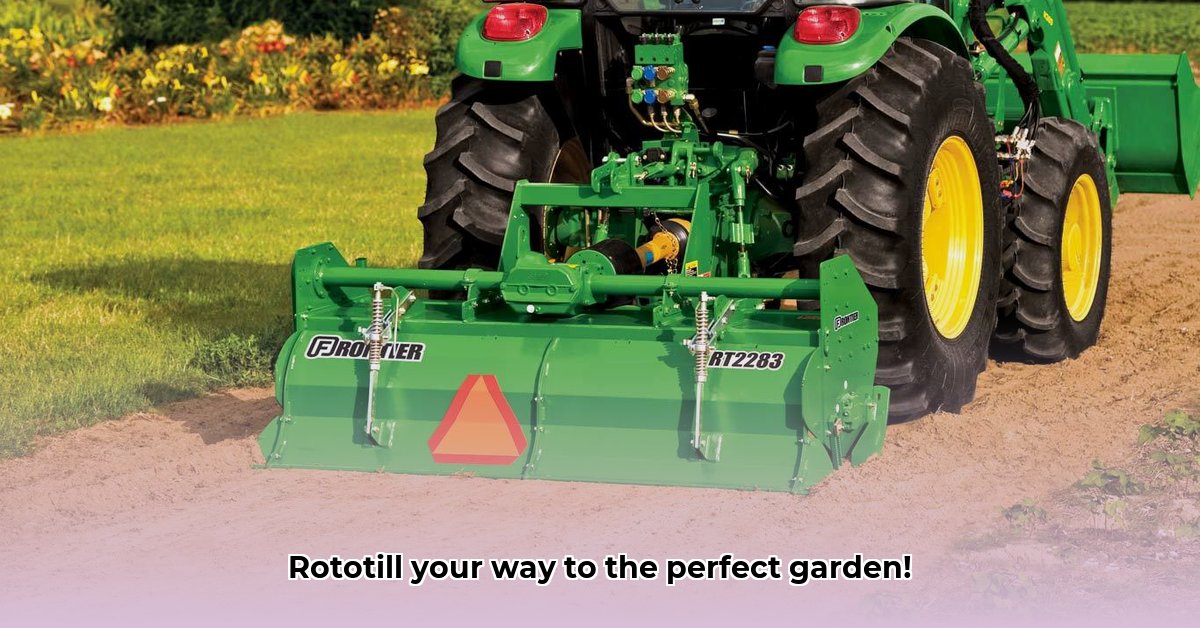
Choosing the right rototiller for your tractor can significantly impact your farming or gardening efficiency. This guide provides actionable advice to help you select the perfect model, whether you're a large-scale farmer or a home gardener. We'll compare popular brands, focusing on key features and their practical implications, to help you make an informed decision. We'll address everything from functionality to maintenance and safety, maximizing your investment and minimizing potential risks. For more in-depth information, check out this helpful resource.
Understanding Rotary Tillers: Preparing Your Soil for Success
Rotary tillers, or rototillers, are tractor attachments designed to break up compacted soil, creating a fine seedbed ideal for planting. This process improves soil aeration, drainage, and overall health, leading to improved plant growth. Think of it as a vigorous workout for your soil, preparing it to yield optimal results.
Rototillers vary in size and features. Lightweight models are suitable for small gardens, while heavy-duty versions are designed for larger farms and fields. Some offer adjustable tilling depth, allowing customization based on soil type and crop. Matching your rototiller to your land area and goals is essential for a successful outcome.
Key Features to Consider: Optimizing Your Rototiller Selection
Selecting the right rototiller requires understanding crucial features that directly impact performance and longevity.
Slip Clutch: This safety mechanism protects your tractor from damage if a blade hits an obstruction. It acts as a shock absorber, preventing the power from damaging the tractor's transmission. Consider it an insurance policy for your equipment.
Number of Blades: More blades typically result in finer tilling, creating a smoother seedbed. However, increased blade count also means increased wear and tear, potentially requiring more frequent maintenance. It's a trade-off between superior tilling and maintenance demands.
Adjustable Hitch: This feature allows you to adjust the tiller's angle and depth, enhancing maneuverability on uneven terrain and around obstacles. It’s like having power steering for your soil preparation.
Offsetting Capability: This enables you to till close to fences, trees, or other boundaries without damage, maximizing space and minimizing wasted effort. This is particularly valuable for maximizing space utilization.
Soil Type and Scale of Operation: The type of soil significantly impacts tiller selection. Heavy clay soil needs a more powerful tiller than light, sandy soil. Similarly, the size of your land—be it a small garden or a large farm—will dictate the necessary tiller size and power.
Comparative Analysis: Sigma vs. Other Brands
Comparing rototillers can be challenging due to inconsistent data availability from manufacturers. This section compares the Sigma tiller from Everything Attachments with models from Tractor Supply Company (TSC), highlighting the limitations of the available data. This is more of a qualitative than quantitative comparison.
The Sigma, for example, features a slip clutch, six blades for thorough tilling, an adjustable hitch, and offsetting capabilities. Specific details on other features are unfortunately not readily available. The data for TSC models is equally limited, hindering a precise feature-by-feature comparison. More in-depth research with manufacturers is needed for definitive conclusions.
| Feature | Sigma (Everything Attachments) | TSC Models (Example) |
|---|---|---|
| Slip Clutch | Yes | Varies (Information Unavailable) |
| Number of Blades | Six | Varies (Information Unavailable) |
| Adjustable Hitch | Yes | Varies (Information Unavailable) |
| Offsetting Capability | Yes | Varies (Information Unavailable) |
Buying Guide and Recommendations: Tailoring Your Choice
The optimal rototiller depends entirely on your needs and budget. This section provides tailored recommendations:
Large-Scale Farmers: Prioritize heavy-duty rototillers like the Sigma, emphasizing durability, efficiency, and features that minimize downtime.
Small-Scale Farmers: Consider smaller, more affordable models, balancing capability with cost-effectiveness. Thorough research across different brands is crucial.
Home Gardeners: Opt for lightweight, compact models suitable for smaller spaces and budgets. Don't overspend on unnecessary features.
Before purchasing, consider:
- The size of your land.
- Your soil type.
- Your budget.
These questions will guide you toward the right choice.
Maintenance and Safety: Prioritizing Responsible Use
Regular maintenance is essential for extending your rototiller's lifespan. This includes:
Regular Inspections: Check for loose bolts, worn blades, and signs of damage after each use.
Lubrication: Keep moving parts lubricated. Refer to your owner's manual for specific lubrication details.
Blade Sharpening: Sharpen blades regularly for efficient tilling.
Proper Storage: Store your tiller to protect it from weather and damage.
Safety is paramount. Always use safety guards and wear appropriate safety gear (sturdy footwear, gloves, and eye protection). Consult your owner's manual for detailed safety instructions. Neglecting safety may lead to injuries or damage to equipment.
Conclusion: Making the Right Investment
Selecting a rototiller is a significant investment. This guide emphasizes the importance of considering individual needs and budgets, providing a framework for informed decision-making. Remember that ongoing research and exploration of various brands are highly recommended for a comprehensive understanding. The ideal choice is entirely subjective, dictated by your unique priorities and operational requirements.